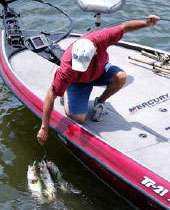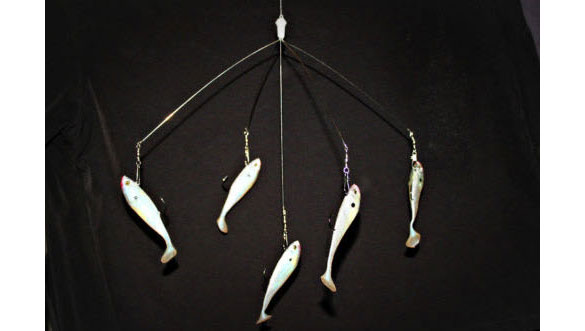
Much has been made about the Alabama rig since Bassmaster Elite Series pro Paul Elias used it to win the FLW Tour Open on Lake Guntersville last week. Apart from the expected demand to get one (or 10) of the things, there’s been a lot of commentary and controversy about the technique, one of the most interesting to hit the bass fishing world in a long time.
So before you decide whether or not the Alabama rig is for you, let’s talk about the issues.
If you’re new to this discourse, we’ll start with a description. The Alabama rig is not a lure, but a device that allows an angler to deliver multiple lures on a single cast. The “Alabama rig” devised by Andy Poss and sold at TheAlabamaRig.com is simply a castable “umbrella” rig.
A Little History
The umbrella rig is an old standby among saltwater trollers targeting striped bass and bluefish off the New England coast. In more recent decades, it’s become popular with trollers chasing landlocked striped bass on waters like Georgia’s Lake Lanier. For the freshwater trollers, the occasional largemouth, smallmouth or spotted bass has been bycatch when after the larger species.
Lore has it that a Montauk, N.Y., skipper got the idea for the umbrella rig after visiting Nova Scotia and seeing anglers troll with strips of beer cans suspended from a metal bar to simulate a school of baitfish. Modern umbrella rigs — including the Alabama rig — have advanced somewhat in terms of the materials used, but the concept and basic presentation is the same.
Whereas traditional umbrella rigs are heavy and somewhat cumbersome things designed to be trolled on wire line, the Alabama rig is lighter and allows for awkward but effective casting. Poss’ version weighs about 3/8-ounce before the first lure is attached. Add some ordinary jig heads and soft plastic baits, though, and the rig could easily top out at better than four full ounces.

The Law in Tennessee
When Elias first learned of the Alabama rig, he intended to use it at Lake Guntersville below the Nickajack Dam. Lucky for him, he didn’t. Those are Tennessee waters, and they were put off limits by tournament officials before the event started. In Tennessee, certain umbrella rigs are illegal. Here’s how that regulation — in place since 2002 — puts it:
“Umbrella Rig Restriction: Umbrella rigs are defined as an array of more than 3 artificial lures or baits (with or without hooks) used by a single rod and reel combination. If the hook size is 6 or larger, then only one lure or bait may have a hook and that hook must be a single hook.”
Therefore, it appears you can use an Alabama rig in Tennessee only if (1) it has three or fewer lures or baits or (2) the hooks you use on the rig are size 6 or smaller or (3) if you choose to use a bigger hook, then only one bait or lure can have a hook in it and it must be a single hook.
Another site erroneously reported that the Tennessee Wildlife Resources Agency had called an emergency meeting to rule on the legality of the Alabama rig and they changed the regs to allow it.
Not true.
After speaking with Bobby Wilson, Chief of Fisheries for TWRA, I can report that no such meeting took place and none is planned. Tennessee’s restriction on umbrella rigs stands as set forth in their fishing regulations. Violate it at your peril.
Wilson expressed concern over the rig’s potential for catching multiple fish at once (which, of course, is something many anglers like about it) and its propensity for foul hooking fish caught on it and adding to mortality rates.
TWRA has been getting so many inquiries re the legality of the Alabama rig, they issued a clarification on Thursday.
The Law in Iowa
The relevant regulation in Iowa covers permissible hook configurations and provides as follows:
“When fishing by hook and line you cannot use more than two lines or more than two hooks on each line when still fishing or trolling…. When you are trolling and bait casting, you cannot use more than two trolling spoons or artificial baits on one line…. One hook means a single, double or treble-pointed hook, and all hooks attached as a part of an artificial bait or lure shall be counted as one hook.”
That seems to pretty much shut the door on using any sort of umbrella rig in Iowa.
The Law in Minnesota
The “Land of 10,000 Lakes” is also no friend to the umbrella rigger. Their regulation regarding hooks reads like this:
“Anglers may use only one hook. An artificial lure is considered one hook. A treble hook, when not part of an artificial lure, is considered three hooks and is not legal. The exception is that three artificial flies may be used when angling for trout, crappie, sunfish, and rock bass.”
Under Minnesota law it appears that two lures equals two hooks and that equals a big no-no.
The Law in Nebraska
Nebraska, perhaps like other states, prohibits anglers from keeping foul-hooked fish. Since the state defines a foul-hooked fish as “any fish hooked externally,” and umbrella rigs have a tendency to result in a good deal of foul-hooking (even of fish that are hooked in the mouth by one of the baits), one wonders if the rig would frequently run afoul of the law in the Cornhusker State.
The Law in [Your State Here]
Better check before you cast!





